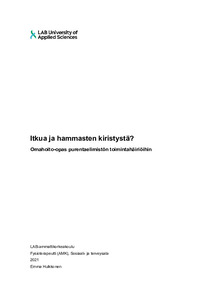Itkua ja hammasten kiristystä? : omahoito-opas purentaelimistön toimintahäiriöihin
Hulkkonen, Emma (2021)
Hulkkonen, Emma
2021
All rights reserved. This publication is copyrighted. You may download, display and print it for Your own personal use. Commercial use is prohibited.
Julkaisun pysyvä osoite on
https://urn.fi/URN:NBN:fi:amk-2021120824561
https://urn.fi/URN:NBN:fi:amk-2021120824561
Tiivistelmä
Purentaelimistön kipu ja toimintahäiriöt (temporomandibular disorders, TMD) on yhteisnimitys puremalihasten, leukanivelten, hampaiston ja niihin läheisesti liittyvien kudosten sairaus- ja kiputiloille sekä toimintahäiriöille. TMD:ssä kivun lisäksi tavallisia oireita ovat äänet leukanivelessä, leukojen väsyminen ja jäykkyys ja leuan liikehäiriöt. Potilaan informoiminen, omahoito-ohjeiden antaminen ja alaleuan liikeharjoitusten ohjeistaminen kuuluvat suositeltaviin ensi vaiheen hoitomuotoihin. TMD:n hoito on usein moniammatillista yhteistyötä potilaan omahoidon kera ja se tehoaa yleensä hyvin purentaelimistön toimintahäiriöihin.
Opinnäytetyön tavoitteena oli tuottaa fysioterapiayrittäjän käyttöön purentaelimistön toimintahäiriöistä kärsivälle asiakkaalle annettava opas, joka sisältää tietoa TMD:stä. Toisena tavoitteena oli sisällyttää oppaaseen asiakkaan omahoitoa tukevia itsenäisesti tehtäviä harjoitteita. Opinnäytetyö toteutettiin toiminnallisena opinnäytetyönä. Oppaan kehittämisprosessi noudatti toiminnalliselle opinnäytetyölle tyypillistä lineaarisen kehittämisprosessin viitekehystä. Oppaan sisällön suunnittelun pohjana käytettiin viimeisimpiä TMD:hen liittyviä tutkimuksia. Kehittämisprosessissa tehtiin vertailuanalyysi ilmestyneistä TMD-oppaista. Oppaan luonnosversio esitettiin ryhmälle asiakkaita ja heiltä kerättiin palautetta Webropol-kyselyllä.
Toiminnallisena tuotoksena valmistunut omahoito-opas sisältää aluksi yleistä tietoa purentaelimistön toimintahäiriöistä, niiden oireista ja hoidosta. Oppaassa on lisäksi lyhyt osio omahoitokeinoista. Oppaan ydin on kuvalliset harjoitusohjeet. Harjoitusohjeet sisältävät leuan liikeharjoitusten ohella myös asento- ja rentoutusharjoituksia. Valmis tuote antaa keinoja asiakkaan omahoitoon sekä tukee fysioterapiayrittäjän yritystoimintaa. Temporomandibular disorders (TMD) is an umbrella term covering pain and dysfunction of the muscles of mastication and the temporomandibular joints and the nerves associated with chronic facial pain. In addition to pain, other common symptoms of TMD include clicking or popping of the jaw, jaw discomfort or soreness and limited mouth motions. Informing the patient, giving self-care instructions and instruction for jaw exercises are among the recommended first-line treatments. Treatment is often a multi-professional collaboration combined with the patient’s self-care and the prognosis for the treatment is usually good.
The goal of the thesis was to produce a guide for the physiotherapy entrepreneur to help the patients with TMD symptoms. The other goal was to include therapeutic exercises in the guide that would support patient’s self-care. The thesis was conducted as a functional thesis and it proceeded according to the linear development model, which is typical for a functional thesis. The latest research on TMD was used as a basis when the content for the guide was designed. During the development process, a benchmarking analysis was done to study and compare other guidebooks of TMD. A draft version of the guide was presented to a group of customers and their feedback was collected with a survey created by Webropol tool.
In addition to the general information about TMD and a short section on self-care methods, the completed guide contains pictorial instructions of therapeutic exercises that support the patient’s self-care. The instructions include jaw exercises, postural exercises and relaxation exercises. The finished product gives self-care tools for TMD patients and supports the business of the physiotherapy entrepreneur.
Opinnäytetyön tavoitteena oli tuottaa fysioterapiayrittäjän käyttöön purentaelimistön toimintahäiriöistä kärsivälle asiakkaalle annettava opas, joka sisältää tietoa TMD:stä. Toisena tavoitteena oli sisällyttää oppaaseen asiakkaan omahoitoa tukevia itsenäisesti tehtäviä harjoitteita. Opinnäytetyö toteutettiin toiminnallisena opinnäytetyönä. Oppaan kehittämisprosessi noudatti toiminnalliselle opinnäytetyölle tyypillistä lineaarisen kehittämisprosessin viitekehystä. Oppaan sisällön suunnittelun pohjana käytettiin viimeisimpiä TMD:hen liittyviä tutkimuksia. Kehittämisprosessissa tehtiin vertailuanalyysi ilmestyneistä TMD-oppaista. Oppaan luonnosversio esitettiin ryhmälle asiakkaita ja heiltä kerättiin palautetta Webropol-kyselyllä.
Toiminnallisena tuotoksena valmistunut omahoito-opas sisältää aluksi yleistä tietoa purentaelimistön toimintahäiriöistä, niiden oireista ja hoidosta. Oppaassa on lisäksi lyhyt osio omahoitokeinoista. Oppaan ydin on kuvalliset harjoitusohjeet. Harjoitusohjeet sisältävät leuan liikeharjoitusten ohella myös asento- ja rentoutusharjoituksia. Valmis tuote antaa keinoja asiakkaan omahoitoon sekä tukee fysioterapiayrittäjän yritystoimintaa.
The goal of the thesis was to produce a guide for the physiotherapy entrepreneur to help the patients with TMD symptoms. The other goal was to include therapeutic exercises in the guide that would support patient’s self-care. The thesis was conducted as a functional thesis and it proceeded according to the linear development model, which is typical for a functional thesis. The latest research on TMD was used as a basis when the content for the guide was designed. During the development process, a benchmarking analysis was done to study and compare other guidebooks of TMD. A draft version of the guide was presented to a group of customers and their feedback was collected with a survey created by Webropol tool.
In addition to the general information about TMD and a short section on self-care methods, the completed guide contains pictorial instructions of therapeutic exercises that support the patient’s self-care. The instructions include jaw exercises, postural exercises and relaxation exercises. The finished product gives self-care tools for TMD patients and supports the business of the physiotherapy entrepreneur.
